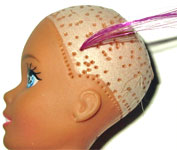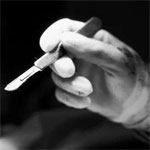 I saw two patients recently that are worthy of discussion here…
I saw two patients recently that are worthy of discussion here…
Patient #1:
He had a typical result from the hair transplant surgeries of the 70s, 80s and early 90s. He had hair transplant plugs in the early 90s which gave him a doll-like hairline in the frontal area. I have worked with him over a 10 year period with four surgeries to remove and thin out the 3 inch wide plugs, redistributing the hair from the plugs to other adjacent areas in an attempt to make them less detectable. He is about 80% closer to his goal over what he had when he first came to see me and now wears a crew cut, but he is still frustrated over the remaining plugs which still bother him when he looks into the mirror every morning. I will continue to work with him, thinning out more plugs until he is satisfied that he looks normal. He shared what it has been like over the past many years, as too much of his life focus revolved around his head and his freaky pluggy look. Fortunately he and I put together a Master Plan 10 years ago to get him back to a normal appearance, and even now, after a decade of my working on him, the process will continue.
Patient #2:
This man has a far worse story. This young man (in his 30s) has had hair transplant work by many doctors over 10 years. Unlike patient #1, he never had a Master Plan and always sought out the best doctor who promised him a quick fix and he believed what the doctors told him. In the midst of the process, he even had a brow lift to raise a hairline that was too low, leaving him scarred in the hairline area. A series of transplants to fix the hair loss from the brow lift in the frontal area failed, compounding the problem further. The donor strips that were taken in the back of his head were all taken in different areas of the scalp and they all stretched and widened substantially. It seemed that the doctors just kept on removing donor hair from different areas to avoid the wide scars previous doctors created.
This man paid tens of thousands of dollars and each successive surgery seemed to leave him worse off. The recent transplants apparently did not work and he asked me if there was something wrong with his skin and recipient areas. I asked him if he called the doctors who did the failed procedures and he said he did call them over and over again, but they never returned his calls. Now he is massively scarred in the back of his head with at least three wide scars each measuring over 1/2+ inch in width. He received body hair transplants into the scar, but the difference was marginal. Each “fix” addressed one problem in isolation of the other problems, resulting (at times) with him being left worse off in the total scheme of things. I don’t know what he will do, but I suggested that he consider working with just one doctor, and building a Master Plan to deal with his problems. One option might be balloon expansion of his scalp to remove the scars in the back of his head by stretching the normal scalp in the crown of his head. The use of balloons to stretch the scalp will take at least 8 weeks of constant inflation of the balloon. If he wanted us to do it in California, he would either have to move to California for the period that the balloon expansion was being done or find a local doctor willing to do the incremental expansion of the balloon in his home town. We have done similar patients with outstanding results, but the commitment of time is substantial. What I gave him was a Master Plan to get him back to a manageable state. Anything short of such a radical approach will just victimized him again and again by some of the doctors who see $$$ in each successive procedure that they can offer him. Too much of his life is being centered around his scalp and the various poor choices he made.
Conclusion:
I often end with the statement: “Let the Buyer Beware,” which is so appropriate in this situation. Doctors are not immune to being scummy. I unfortunately see horror stories like this almost every week, and I post these as a way to educate you (the consumer) so that you can make informed decisions and avoid being taken advantage of.
How do I end a post like this positively? Well, today’s hair transplants in the hands of good and honest doctors are spectacular. At last night’s Open House event in our LA office, Steve Hartman (CBS Sports announcer and radio show host) who is himself a hair transplant patient, told me that not only was his procedure undetectable, but that he and many of the patients who were there looked like they never lost a hair on their head. Those horror stories I wrote about above rarely happen today. There are rotten applies in every barrel, but there are many really great doctors also in that barrel. You just have to do your research before you jump.
![]()
![]()


 I suppose if you see stubs of hair follicles out of your body with bulbs on them, it could reflect grafts and if that’s the case, what you lost will never grow. I’m really not sure what you’re seeing. A tight hat can pull out grafts, though the grafts should’ve been secured by the 5 day mark. I don’t know enough about your surgery — like where you had your hair transplant or what was really done.
I suppose if you see stubs of hair follicles out of your body with bulbs on them, it could reflect grafts and if that’s the case, what you lost will never grow. I’m really not sure what you’re seeing. A tight hat can pull out grafts, though the grafts should’ve been secured by the 5 day mark. I don’t know enough about your surgery — like where you had your hair transplant or what was really done. I saw two patients recently that are worthy of discussion here…
I saw two patients recently that are worthy of discussion here… The only reason to use a multi-bladed knife above 2 blades relates to the time efficiency of the work, the need for less well-trained technicians, and the surgeons ability to do more grafts with less staff. The real expense however, is in the damage done to the hair and the hair that is lost. There are no patient benefits when using an 8 bladed knife (for example) over visual dissection of the scalp under a high-powered microscope.
The only reason to use a multi-bladed knife above 2 blades relates to the time efficiency of the work, the need for less well-trained technicians, and the surgeons ability to do more grafts with less staff. The real expense however, is in the damage done to the hair and the hair that is lost. There are no patient benefits when using an 8 bladed knife (for example) over visual dissection of the scalp under a high-powered microscope.